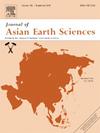Genesis of dykes and mantle-crust interaction in the Keregetas swarm, Eastern Kazakhstan
IF 2.7
3区 地球科学
Q2 GEOSCIENCES, MULTIDISCIPLINARY
引用次数: 0
Abstract
Post-orogenic dyke swarms have occurred in many orogens within the CAOB. The dyke swarms that contains various rocks can provide information about the process of mantle magmas differentiation during uplift and interaction with crustal material at different levels. The Keregetas dyke swarm (Eastern Kazakhstan) contain more than 200 dykes of different compositions, intrusions of biotite granites and amphibole leucogranites in a comparatively small area. We present geochronology, petrography, mineralogy, major and trace element chemistry and Nd isotopic data. U-Pb (zircon) and Ar-Ar (amphibole) geochronological data indicate that all rocks were emplaced synchronously in the Early Permian (292–282 Ma). Detailed study of the mineralogical and geochemical data suggests that the two processes determined the magmatic rock diversity within Keregetas swarm: differentiation of the parental mafic magma and melting of crustal sources at different levels. All rocks show positive ℇNd(T) values which confirms the role of upper mantle in their formation. A two-stage model for the formation of the Keregetas dyke swarm was proposed: (1) differentiation and assimilation of mafic magma and the formation of leucogranitic magma during partial melting in the lower crust, and (2) the formation of granodiorite and granite magmas as a result of partial melting in the middle crust. The geodynamic setting responsible for the formation of the Keregetas dyke swarm was the process of post-collisional lithosphere extension in the Early Permian, occurring against the backdrop of a thermal anomaly in the upper mantle caused by the activity of the Tarim mantle plume.

哈萨克斯坦东部Keregetas群岩脉成因与幔壳相互作用
造山后岩脉群在黄岩带内的许多造山带都发生过。岩脉群包含多种岩石,可以提供地幔岩浆在隆升过程中的分异过程以及与不同层次地壳物质相互作用的信息。在哈萨克斯坦东部的Keregetas岩脉群中,有200多条不同组成的岩脉,侵入体为黑云母花岗岩和角闪孔浅花岗岩。我们介绍了地质年代学、岩石学、矿物学、主微量元素化学和钕同位素数据。U-Pb(锆石)和Ar-Ar(角闪孔)年代学资料表明,所有岩石均在早二叠世(292-282 Ma)同步侵位。详细的矿物学和地球化学研究表明:母基性岩浆的分异作用和不同程度的地壳源熔融作用决定了Keregetas群内岩浆岩的多样性。所有岩石的Nd(T)值均为ℇ正,证实了上地幔在其形成过程中的作用。提出了Keregetas岩脉群形成的两阶段模式:(1)下地壳部分熔融过程中基性岩浆的分异同化和白花岗质岩浆的形成;(2)中地壳部分熔融过程中花岗闪长岩和花岗岩浆岩的形成。Keregetas岩脉群形成的地球动力学背景是早二叠世碰撞后岩石圈伸展过程,发生在塔里木地幔柱活动引起的上地幔热异常背景下。
本文章由计算机程序翻译,如有差异,请以英文原文为准。
求助全文
约1分钟内获得全文
求助全文
来源期刊

Journal of Asian Earth Sciences
地学-地球科学综合
CiteScore
5.90
自引率
10.00%
发文量
324
审稿时长
71 days
期刊介绍:
Journal of Asian Earth Sciences has an open access mirror journal Journal of Asian Earth Sciences: X, sharing the same aims and scope, editorial team, submission system and rigorous peer review.
The Journal of Asian Earth Sciences is an international interdisciplinary journal devoted to all aspects of research related to the solid Earth Sciences of Asia. The Journal publishes high quality, peer-reviewed scientific papers on the regional geology, tectonics, geochemistry and geophysics of Asia. It will be devoted primarily to research papers but short communications relating to new developments of broad interest, reviews and book reviews will also be included. Papers must have international appeal and should present work of more than local significance.
The scope includes deep processes of the Asian continent and its adjacent oceans; seismology and earthquakes; orogeny, magmatism, metamorphism and volcanism; growth, deformation and destruction of the Asian crust; crust-mantle interaction; evolution of life (early life, biostratigraphy, biogeography and mass-extinction); fluids, fluxes and reservoirs of mineral and energy resources; surface processes (weathering, erosion, transport and deposition of sediments) and resulting geomorphology; and the response of the Earth to global climate change as viewed within the Asian continent and surrounding oceans.
 求助内容:
求助内容: 应助结果提醒方式:
应助结果提醒方式:


